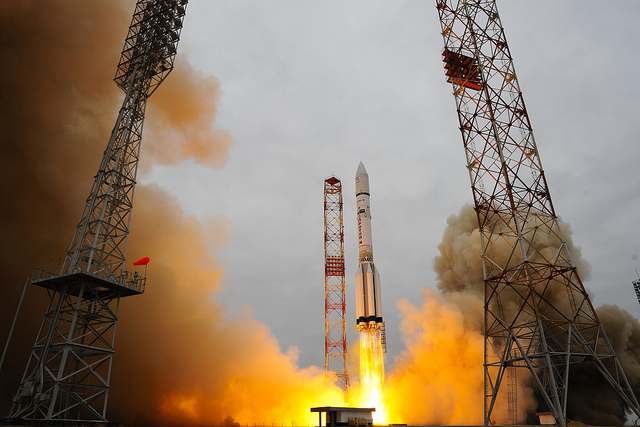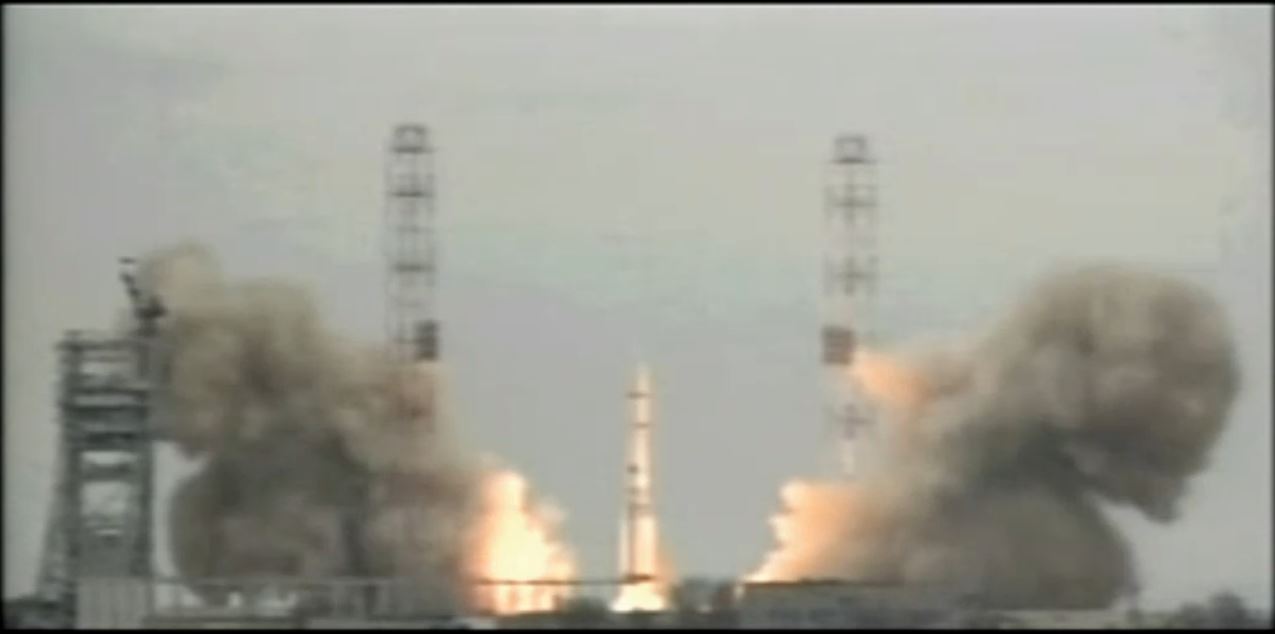

This story was updated at 6:10 p.m. EDT.
Next stop, Mars!
Two robotic spacecraft began a seven-month journey to the Red Planet today (March 14), blasting off together atop a Russian Proton-M rocket from Baikonur Cosmodrome in Kazakhstan at 5:31 a.m. EDT (0931 GMT; 3:31 p.m. local Kazakhstan time).
The spacecraft — the Trace Gas Orbiter (TGO) and a lander called Schiaparelli — constitute the first part of the two-phase ExoMars program, a European-Russian project to hunt for signs of life on the Red Planet. The second phase will launch a deep-drilling rover in 2018, if current schedules hold. [The ExoMars 2016 Mission: Complete Coverage]
TGO phoned home at 5:30 p.m. EST (2130 GMT) today, right on schedule, and the orbiter's solar arrays deployed a few minutes later, mission team members said.
"We have a mission!" ExoMars flight operations director Michel Denis said from ESA's control center in Darmstadt, Germany, just after TGO's signal was received. "Go, go, go ExoMars!"
ExoMars represents a significant broadening of the scientific research effort at Mars, which has been dominated by NASA for the past two decades. For example, the European Space Agency (ESA) mounted just one Red Planet mission prior to ExoMars — Mars Express, which launched in 2003 — and Russia has not yet achieved any interplanetary successes (though the same cannot be said of its predecessor nation, the Soviet Union).
Get the Space.com Newsletter
Breaking space news, the latest updates on rocket launches, skywatching events and more!
Searching for signs of life

If all goes according to plan, TGO and Schiaparelli will separate from each other on Oct. 16, as the duo are approaching Mars. [Gallery: Europe's ExoMars 2016 Mission in Pictures]
The 8,220-lb. (3,730 kilograms) TGO will enter orbit around the Red Planet on Oct. 19, then eventually work its way to a circular orbit with an altitude of about 250 miles (400 kilometers). From this vantage point, the spacecraft will study the Martian surface and atmosphere using four different science instruments during a five-year mission that's expected to begin in December 2017.
TGO's chief task is to hunt for methane and its degradation products in Mars' air. The vast majority of methane in Earth's atmosphere is produced by microbes and other living organisms, so the gas is viewed as a possible sign of Red Planet life, if any exists.
However, geological processes can also generate methane, so a detection of the gas is not a slam dunk for life. Indeed, NASA's Mars rover Curiosity detected a 10-fold jump in methane levels in late 2013 and early 2014, but mission scientists still aren't sure what caused it.
TGO will do other jobs as well. For example, the photos it takes will help the ExoMars team choose a landing spot for the 2018 rover. And the solar-powered orbiter will serve as a communications link between that rover and Earth.
The orbiter's "instruments will also map the subsurface hydrogen to a depth of a meter [3.3 feet], with improved spatial resolution compared with previous measurements," ESA officials wrote in a description of TGO. "This could reveal deposits of water ice hidden just below the surface, which, along with locations identified as sources of the trace gases, could influence the choice of landing sites of future missions."
Landing on Mars

While TGO sets up shop in orbit, the 1,320-lb. (660 kg) Schiaparelli craft will head toward the Martian surface for a planned Oct. 19 landing. [How ExoMars TGO Will Hunt for Mars Methane (Video)]
If it works, the touchdown will be a historic moment: ESA has never mounted a successful mission to the surface of another planet. (ESA's Beagle 2 lander, which traveled to the Red Planet with Mars Express, apparently touched down softly as planned, but it never sent any data home from the Martian surface. But it's worth mentioning that the agency's Huygens lander — part of the NASA-ESA Cassini-Huygens mission — operated on Saturn's huge moon Titan in early 2005.)
Schiaparelli carries several different scientific instruments, including one package that will collect a variety of meteorological data at the probe's landing site in Mars' Meridiani Planum region.
But these instruments will likely operate for just a few days, until Schiaparelli's batteries run out. The probe's primary purpose is to prove out the entry, descent and landing technology needed to get the life-hunting ExoMars rover on the ground several years from now.
Europe and Russia team up
ESA leads the ExoMars program and is responsible for most of the spacecraft hardware. NASA was the original ExoMars partner, but the American space agency dropped out in early 2012, citing budget issues. (NASA is currently working on its own life-hunting Mars rover, which is scheduled to launch in 2020.)
Russia came aboard ExoMars to fill NASA's shoes. Russia's Federal Space Agency, known as Roscosmos, is providing Proton rockets for both of the ExoMars launches, as well as several scientific instruments and the 2018 rover's landing platform.
ESA and Roscosmos will both notch huge milestones if ExoMars goes well. Since emerging from the 1991 collapse of the Soviet Union, Russia has launched two missions to the Red Planet: Mars 96, in 1996, and Phobos-Grunt, in 2011. Neither one made it out of Earth orbit.
The Soviet Union, of course, had a lengthy history of Mars exploration. But, while the nation did score a few notable successes — such as the Mars 2 orbiter, which sent photos of the Red Planet back to Earth in 1971-1972 — the majority of Soviet Mars missions failed.
The ExoMars program is expected to cost ESA 1.3 billion euros (about $1.45 billion at current exchange rates), ESA officials have said.
Follow Mike Wall on Twitter @michaeldwall and Google+. Follow us @Spacedotcom, Facebook or Google+. Originally published on Space.com.
Join our Space Forums to keep talking space on the latest missions, night sky and more! And if you have a news tip, correction or comment, let us know at: community@space.com.

Michael Wall is a Senior Space Writer with Space.com and joined the team in 2010. He primarily covers exoplanets, spaceflight and military space, but has been known to dabble in the space art beat. His book about the search for alien life, "Out There," was published on Nov. 13, 2018. Before becoming a science writer, Michael worked as a herpetologist and wildlife biologist. He has a Ph.D. in evolutionary biology from the University of Sydney, Australia, a bachelor's degree from the University of Arizona, and a graduate certificate in science writing from the University of California, Santa Cruz. To find out what his latest project is, you can follow Michael on Twitter.









